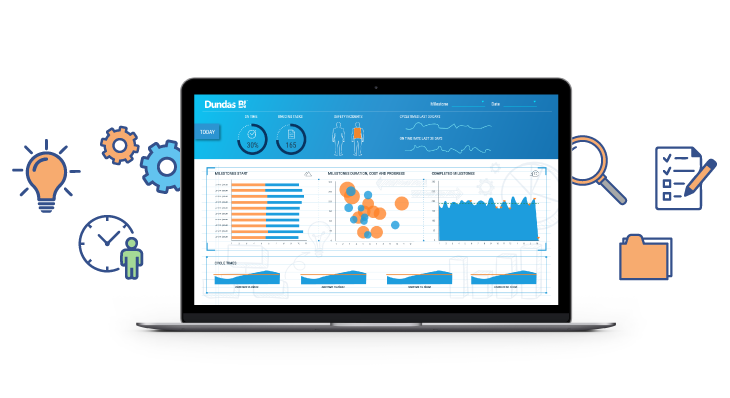
Too often people equate BI with reports or dashboards but those are the end results. There’s a lot more at play before one reaches that stage (read: final stage) of business intelligence. And even before one begins the process of building a BI solution, there’s one critical exercise that defines the project’s scope: requirements gathering.
Like any other project, to make your Business Intelligence (BI) project a real success, comprehensive requirements gathering is the first and the most important step of the journey.
Why is business intelligence requirements gathering important?
Each department of a business has different goals and objectives they wish to achieve with the help of business intelligence and analytics and therefore their requirements are different too. A well-documented BI Solution Requirements Report will result in the following:
- Address business, data, technical, and usage needs
- Uncover current and future needs
- Save time by providing the team with a constant point of reference during the BI software solution selection phase as well as in the implementation phase
4 Types of Assessments to Identify Your Business Intelligence & Analytics Requirements
The following four assessments highlight the areas an organization must focus on for its BI requirements gathering exercise:
- Business Assessment
A business assessment ensures your business is well equipped with what it needs to deliver on your goals. It provides a guideline to help you scale your business in a way that is smart and strategic. The secret to conducting useful business assessments that provide actionable insights is to analyze appropriate Key Performance Indicators (KPIs).
KPIs keep business objectives at the forefront. They are the metrics that provide answers to the right questions or monitor the health of the areas of your business in consideration. With the right selection of KPIs you evaluate how a BI solution needs to address pain points experienced in the past, how should it deliver on the current needs and finally how will it scale to cover future wants.
Since KPIs also play a pivotal role in keeping your business intelligence projects on track, we have created a KPIs for BI Template that will assist you in the exercise of choosing the right ones. - Data Assessment
The truthfulness of the analysis is directly proportional to the integrity of the data. A data assessment report can identify data quantity, complexity and active versus inactive data – critical for project scoping. It includes various quality checks which provide information on data relevancy, business data readiness, target readiness and gap analysis.
Data Assessment must also confirm that the data is applicable to the KPIs. You may have the right KPIs defined in the Business Assessment Report but if there’s a mismatch between your data and KPIs, you need to relook at your data. Finally, a thorough data assessment will also reduce unnecessary infrastructure costs and the complexity of your new system - ensuring better operational efficiencies. - User Group Assessment
Business intelligence is a process that sees many users participate at various stages starting with data transformation performed by technical users and ending with reports or dashboards consumed by business users. Each group has specific requirements from the BI solution. Profiling them helps in understanding their consumption and usage patterns which comes in handy while selecting and designing dashboards. - Security Assessment
When there are multiple users and datasets involved in the project, it’s crucial to know in advance how the interactivity will take place, how will users be authenticated, what is the back-end architecture, and where is the solution going to be integrated. Finally, if there are any security checkpoints already in place that needs to be considered, or if any extra security checks need to be put in place.
Once these assessments are done, you will be in a comfortable position to create realistic timelines with your BI implementation team.
Business Intelligence Requirements Gathering Guidelines
To make the business intelligence requirement gathering exercise easier for you, here are two templates you could refer to. They should provide you with a detailed guideline to create a comprehensive BI Requirements Report to work with. We recommend the same to our clients before we jump on our first call with them to discuss dashboard implementations. It helps us as a team to significantly reduce the turnaround time.
BI Solution Requirements Gathering Template (Dundas BI)
Key Performance Indicators (KPIs) Template (Dundas BI)
Let’s chart your BI roadmap together!
Whether your project needs to be completed next week or next year, our team of Professional Services Consultants can help you meet your data analytics objectives faster, accelerating your time to value.
Choosing to opt for consultancy services helps you navigate your options and sets you up for success. Irrespective of how unique your deployment and environment are, whether you are implementing our business intelligence platform for the first time or migrating from another vendor to Dundas BI.
We will be happy to assist you, provide consulting and perform a complimentary live demo of Dundas BI for you and your team.
About the Author

Dany Nehme is the Manager of Professional Services at Dundas Data Visualization. As the leader of the Professional Services team, Dany works with his BI Consultants to ensure they provide guidance to both veteran and new Dundas BI clients, enabling them to implement Dashboards and custom solutions in a best practices manner.
Follow on Linkedin



Follow Us
Support